Research Article
PERCEIVED PARAGLIDING SAFETY CONCERNS AMONG LOCALS IN POKHARA- A TOURISM CAPITAL OF NEPAL
7826
Views & Citations6826
Likes & Shares
Adventurous entertainment and safety concern is the most likely course of action before
choosing any destination for the adventurous tourists. Himalayan expedition, trekking, bungee
jumping, rafting, mountain flights and paragliding are the most chosen activities by tourists in Nepal. In Nepal, Pokhara is being developed as hub of paragliding tourism or the main destination for tourists due to the availability of multiple companies. In fact, most of the tourists who want adventurous entertainment, paragliding is the common to all visitors due to the availability and short span of time who visits Pokhara. Therefore, the safety and security in paragliding of Pokhara is an important factor that influences the fate of the Nepalese adventurous tourism industry. However, there is a lack of research to understand the safety and security arrangement in paragliding industry of Pokhara. The purpose of this exploratory study is to assess the overall paragliding safety situation and challenges in Pokhara. Descriptive statistics are used to present the findings. Findings suggest that paragliding sector of Pokhara has many areas for improvement to provide better and secure tourist experiences. Since Pokhara is a starting and concluding point of attraction for tourists in Western Nepal, I offer important managerial implications and future research directions.
Keywords: Safety, Security, Adventurous tourism, Nepal
choosing any destination for the adventurous tourists. Himalayan expedition, trekking, bungee
jumping, rafting, mountain flights and paragliding are the most chosen activities by tourists in Nepal. In Nepal, Pokhara is being developed as hub of paragliding tourism or the main destination for tourists due to the availability of multiple companies. In fact, most of the tourists who want adventurous entertainment, paragliding is the common to all visitors due to the availability and short span of time who visits Pokhara. Therefore, the safety and security in paragliding of Pokhara is an important factor that influences the fate of the Nepalese adventurous tourism industry. However, there is a lack of research to understand the safety and security arrangement in paragliding industry of Pokhara. The purpose of this exploratory study is to assess the overall paragliding safety situation and challenges in Pokhara. Descriptive statistics are used to present the findings. Findings suggest that paragliding sector of Pokhara has many areas for improvement to provide better and secure tourist experiences. Since Pokhara is a starting and concluding point of attraction for tourists in Western Nepal, I offer important managerial implications and future research directions.
Keywords: Safety, Security, Adventurous tourism, Nepal
INTRODUCTION
Pokhara, a city of Nepal, is renowned as the city of seven lakes and natural beauty across the globe. It is considered as the gateway to the different Himalayan trekking circuits like Annapurna circuit, Dhaulagiri circuit, upper Mustang and Hindu pilgrimage sites beyond the Himalaya like Muktinath temple, Damodar Kunda etc. It is also famous as the city of multiple choices to tourists (Sharma, 2017). Trekking, hiking, paragliding, ultra- light, sky-driving, zip flyer, bungee jumping, canyoning, boating, mountain biking, religious sites and night life are the major attraction of Pokhara. Shadow of Fishtail (Machhapuchhre) reflecting into Fewa Lake is another uniqueness and beauty of Pokhara. Fewa lake, Begnas Lake, Rupa Lake, Bindhyabasini temple, Talbarahi temple, Gupteshower temple, Ram temple, Dhorbarahi temple, Davis fall, Sarangkot, Mahendra cave etc are the major touristic sites of Pokhara.
Paragliding is a simple way for humans to fly openly in the sky. It is an activity with combination of adventure, thrill and fun along with high degree of risk, thus has been categorized as an extreme sport. The popularity of this sport is experiencing upward trend with the time and is attracting more and more attention day by day. There are many companies and organizations in the different corners of the world providing paragliding service. Most of them are actively involved in this sport considering it as a profession (Magar, 2020).
According to the official tourism website for Nepal, Paragliding has been in vogue in Nepal since 1995 and the sport is getting ever more popular. Pokhara has been nominated world's fifth-best paragliding destination. Sunrise Paragliding is Nepal's first Paragliding Company established in 2000 AD, with the help of British Pilot, Adam Hill. There are many paragliding companies to provide daily service. The paraglide starts from the place called ‘Sarangkot' and ends in the bank of Phewa lake. It is approximately 20-30 minutes of glide. An experienced people who have sufficient knowledge regarding paragliding can fly without a pilot, but the permission of flight aviation authority is needed, and an inexperienced people can experience the paragliding with the pilot, provided by paragliding companies (Adhikari, 2019).
Nepal Airsports Association is working closely with the Ministry of Tourism, Civil Aviation Authority of Nepal (CAAN) and Nepal Sports Council to protect, develop and preserve airsports activities specially paragliding. In 2019 it was certified as an authorized agency of Civil Aviation Authority of Nepal (CAAN) (Magar, 2020). It also regulates monitors, develops, enact policies and implements it. There are over 60 tandem operator companies that have taken the membership of NAA by 2018. It has also stated that 294 tandem pilots and 50 solo pilots have taken the membership of NAA and involved in various tandem operating companies within Nepal. Although Nepal has several places for paragliding, Sarangkot, Pokhara is the most popular destination for paraglider lovers (Nepal Airsports Association, 2020).
Paragliding has taken off in Pokhara as a thrilling adventure sport, with over 50 companies providing paragliding services. But a spate of recent accidents has raised questions over the kinds of safety measures paragliding companies have in place, and who is responsible when something goes wrong. In the past year alone, there have been 20 paragliding accidents resulting in serious injuries, according to the Pokhara Police. But all the time weather and pilots are being blamed and cases are not taken seriously by concern authorities (Gurung, 2019).
LITERATURE REVIEW: PARAGLIDING AND SAFETY
Youell (1982) describes that tourism development involves many complex issues that can have both positive benefits and negative impacts on local communities. These positive and negative impacts are commonly called “tourism impacts” (Mathieson & Wall, 1982). In recent years, several researchers have focused on local residents’ perceptions of tourism impacts, and usually employ the theory of the “triple bottom line (TBL)” to assess the issue of hosting events at a tourist attraction or that involve sustainable development among economic, sociocultural, and environmental aspects (Ritchie, Shipway, & Cleeve, 2009; Slaper & Hall, 2011; Stylidis, Biran, Sit, & Szivas, 2014).
Many authors including Kadel et al. (2018) found that Paragliding is an adventurous aerial sport which is performed regularly in and around Pokhara. The Western Region of Nepal (Especially Pokhara, Parbat, Baglung and Syanjya) is famous not only for its natural beauty but for adventurous sports like paragliding, ultraflight and bungee jumping etc. The growing popularity of paragliding sport has led to a steady increase in the number of associated injuries. Among 60 people who faced accidents and brought to hospital, four of them with severe multiple trauma were declared dead in the emergency department at the time of arrival. Fifty-six patients were injured with varieties of injury. Among 56 survived patients, 14 (25%) were minor injuries and discharged from the Emergency Department after treatment for soft tissue trauma like abrasion or sprain. Twelve patients with polytrauma (Including four chest injury, two abdominal injury with multiple bone fractures) and rest of the patients were admitted and treated/reffered/discharged (Kadel et al., 2018).
Pokhara Police have arrested the operator and an instructor of Blue-Sky Paragliding on 26 July 2017 after receiving frequent complaints that their negligence led to the death of the trainees. The duo has been accused of not maintain proper safety standards during training. The complaint recorded by police in Pokhara states that the negligence of the operator and instructors of the paragliding institution led to the death of 26-year-old entrepreneur and managing director of Skylark travel of Pokhara late Prabhat Subedi in course of training (New Business Age, 2017).
Pokharel, S. (2019) a reporter of myrepublica mentioned that on 6 March 2019: A Russian national died in a paragliding accident on Tuesday in the tourist-hub of Pokhara. He is the second person to die in a paragliding accident in three days. Four paragliding accidents have been recorded in Pokhara in the past three days alone. Along with the two deaths, two paragliders were injured. All four accidents were associated with solo paragliding. In the past four years, paragliding accidents have claimed eight lives here. All these accidents, except one, involved solo paragliders. The Civil Aviation Authority of Nepal (CAAN), the regulatory body, has announced a 15-day ban on solo paragliding 'to prevent more accidents'. CAAN's Pokhara office and the operating companies have blamed solo pilots' carelessness for the accidents, but the local population, investigators and police do not agree on it. Weak safety measures of Paragliding operators, lack of monitoring officials and lack of laws for adventure sports in Nepal to make responsible and accountable to the paragliding operators and concerns authorities.
METHOD
Study Context
A Japanese Buddhist monk Ekai Kawaguchi in course of his visit to Tibet in 1889 A.D. appreciated the enchanting beauty of Pokhara in his book titled ‘Three years in Tibet’ contributed the Valley to explore as a tourist destination. First ascend of Mt. Annapurna I by Maurice Herzong in 1950 with global media coverage publicized Pokhara as a beautiful mountainous tourism destination while Mount Everest (Sagarmatha in Nepali) was first climbed by Sir Edmund Hillary and Tensing Sherpa in 1953. Construction of airport, Sunauli-Pokhara highway in 1952 A.D and Prithvi highway in 1976 A.D. connected the valley to the other parts of the country as well as made access to the people from the world (Sharma, 2017).
The focused study area for this research is Sarangkot, Khapaudi, Pame and Lakeside of Pokhara from the Kaski district of Nepal where the paragliding activities and accidents occurs (Figure 1 & 2). Since Pokhara represents many tourism destinations of western Nepal because of the mass tourists' attraction, conducting this study in Pokhara provides a good reflection of Nepal’s tourism security. To study paragliding safe in Nepal, Pokhara appears an appropriate place considering the flow of adventurous and sports tourists and being a tourist-hub, which attracts almost all the adventurous tourists who visit Nepal.
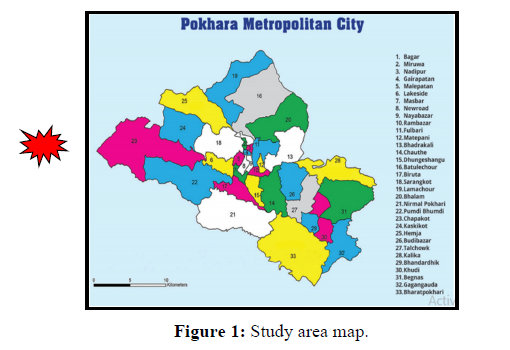
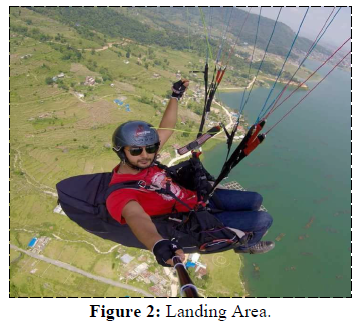


Data Collection and Analysis
This study utilized a mixed-methods approach. The data was collected through a questionnaire survey with local population around Lakeside area of Pokhara. In addition to the survey with the locals, informal communication with stakeholders was included. Related stakeholders of Pokhara include local population, paragliding operators, paragliding pilot both tandem and solo, local police, and rescue team of Armed Police Force (APF). Meanwhile, direct field observation was used. Field observations were made during the study to obtain information and verify the information regarding paragliding safety arrangement and system in summer of 2019 and 2020. Due to the exploratory nature of the study, data analysis includes simple descriptive statistics along with visualizations of the findings created using UCINET-a social network analysis software (Sharma et al., 2020).
RESULTS
Respondents’ Profile
Among 103 respondents; the majority were from local residents followed by Armed Police Force (APF) Disaster Rescue Team, paragliding operators, paragliding solo pilot, tandem pilot and local police (Table 1). Most of the respondents fall within the age group of 22 to 40 years old which represents nearly 39% of all respondents. Most of the respondents were well educated. Most of the participants (41%) in this study had income less than $1,000 per month. Specifically, nearly 39% had income less than $2,000, 11% had income between $2,000 and $5,000 (Table 1).
Locals’ Perceptions of Paragliding Safety Arrangements in Pokhara
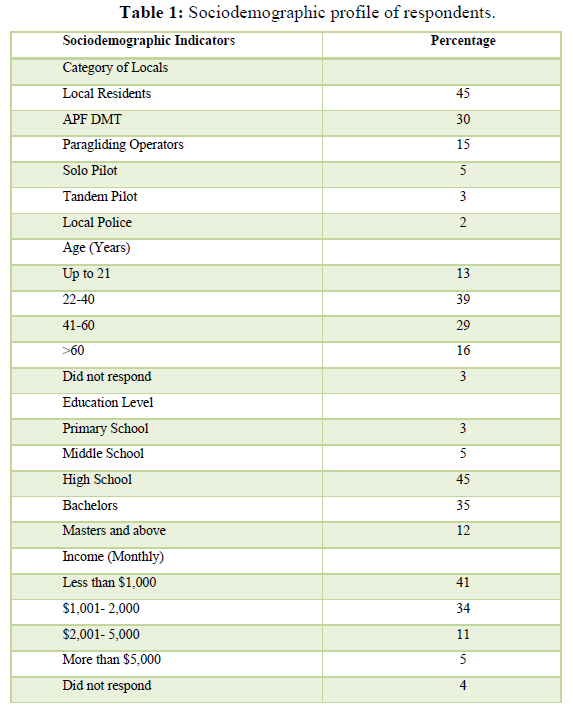

Above Table 1 describes that 102 responded out of 103 for this survey questions. More than 72% of the respondents felt that there was insecure arrangement of Paragliding industry in Pokhara while 26% respondents felt secure. Even though the safety arrangement of paragliding in Pokhara is not secure, many researches have been shown that overall security arrangement in tourism industry of Pokhara is very safe (Sharma, 2017). As the Government of Nepal has been planning to celebrate different years as a tourism year with a target to attract from one to two million tourists’ worse safety arrangements like in paragliding may hamper the goal of tourists’ attraction (Table 2).
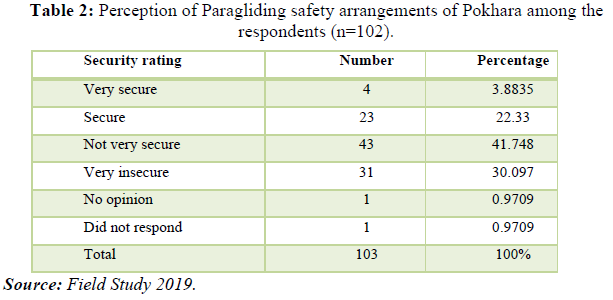

When inquired about responsible for the safety and security threat in paragliding industry of Pokhara valley, that they perceive as important, more than half (50%) of contributors saw pilots and company operators responsible for creating safety threats. However, 19% perceived lack of rescuers on spot is the third larger reason for safety and security threat. Respondents emphasize that paragliding sector of Pokhara also need to organize their own private rescue team consisting with full medical doctor for prompt respond to paragliding accidents and to reduce the death rate for not being got timely rescue. Likewise, 13% of responded saw weather condition of Pokhara is responsible for safety threat and 12% saw equipments. Respondents believe that if company operators and pilots leave some greedy attitude of making more money or if not encourage flying in worse weather than accident rate will be reduced automatically. Nearly 5% did not respond to this question. Given different level of safety and security threats local stakeholders perceive, it is essential to take it seriously and develop a safety measure, respond and program to make all tourists feel safe physically as well as mentally. Effective actions need to be taken to reduce the unwanted paragliding accidents in Pokhara valley (Figure 3).
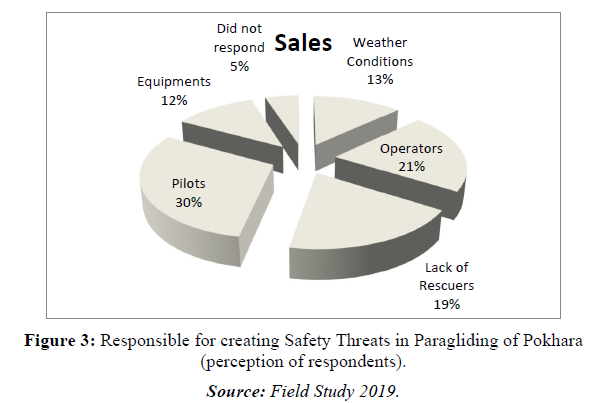

The respondents were asked to rank the most reliable security provider in a scale of one to six, where one indicated most reliable security provider, while six indicates least reliable security provider. There were six choices which are pilots, rescuers of APF Disaster Management Team, Local people, local police, tourist police and paragliding company operators respectively. This survey has shown that paragliding company operators and paragliding training companies needs to be more responsible and accountable to minimize the safety threats and paragliding accidents in Pokhara valley (Figure 4).
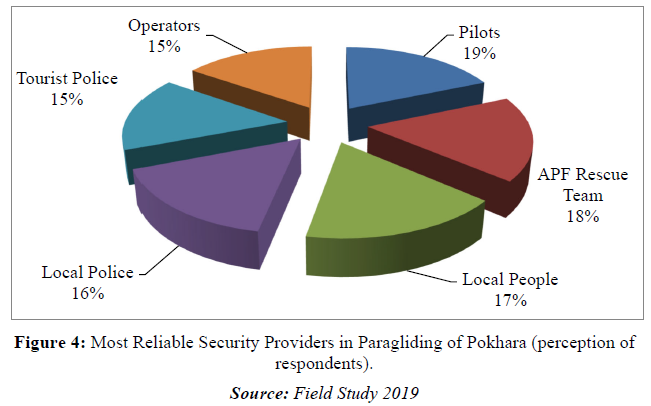

The respondents were asked to rank various factors in the order of importance that are vital for reducing paragliding accident in Pokhara in a scale of one to nine, one indicates most vital factor while nine indicates least important. The choices presented were honesty in Business, local’s awareness, Law Execution, police mobilization, training and equipment of rescuers, dedicated private rescuers, professional monitoring mechanism, national character of people and professional pilots and trainers. The respondents also emphasize that pilots and company operators must be focused more on safety of their customer than making money. Company operators should discourage to paraglide to pilot and customers if weather is not favorable to fly. Law executing and monitoring bodies of both government and private sector also need to be honest and professional to reduce the unwanted accidents in paragliding (Figure 5).
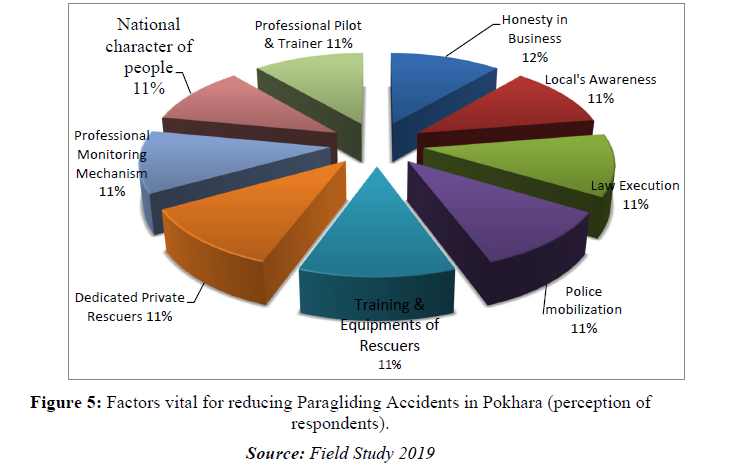

DISCUSSION AND CONCLUSION
Based on the residents’ perspective, it can be observed that each variable that significantly influenced the economy, socio-culture, and environment was not necessarily consistent with respect to various positive benefits and negative impact costs related to Sport Tourism Development (Lin and Lu, 2016). This research was mainly focused on the safety aspect of the tourism industry, especially in the paragliding sector of Pokhara, Nepal. This research sought to cover overall safety and security perceptions and concerns faced by the paragliding sector of Pokhara. Overall, the findings suggest that the safety measurement taken is not satisfactory, but still there are areas for improvement. The findings suggest that there are several safety challenges in paragliding sector of Pokhara. With the Government of Nepal’s vision to increase the number of tourists to Nepal, several safety arrangements need to be improved in advance on adventurous tourism sports or activities. As discussed before, there are several dimensions to deal with. First, to address the pilots and company operators’ factor of safety threats as per (Figure 3). The identification of their causes for not being more accountable, responsible and professional is required. The results provided evidence of the perceptions of vulnerability within the paragliding sector; some alternatives to reduce these risks are the honesty of company operators, pilots and monitoring mechanism of both government and private sector. In addition, proper mobilization of rescuers, local people and local police is required. Paragliding sector also need to organize their own rescue team consisting of medical doctor, nurses, deep diving persons and disaster management team as Armed Police Force has in Pokhara.
Eventually, a general local plan for paragliding sector of Pokhara should include all the factors identified as relevant by the respondents: honesty in Business, local’s awareness, Law Execution, police mobilization, training and equipment of rescuers, dedicated private rescuers, professional monitoring mechanism, national character of people and professional pilot and trainer. Overall, the current perceptions of safe in paragliding safe arrangements are not satisfactory, however, there are very few factors showed the necessity to be improved. By creating a plan and proper monitoring mechanism that would set the goals, objectives, and strategies to lead Nepal in achieving their purpose of attracting double size of international tourists than now.
IMPLICATIONS AND FUTURE RESEARCH
This exploratory study delves into safety and security issues in a paragliding industry of tourism hub of Pokhara. It holds significant importance despite the exploratory nature of the study because perceived paragliding safety concerns among local populations and other stakeholder in Pokhara affect tourists’ visitations to other adventurous tourism destinations of Western Nepal as well as their re-paragliding intentions. As Pokhara, is the gateway of the adventurous tourism, sport and journey to western Nepal, paragliding industry is an important to positively influence the tourists in Nepal. Therefore, an important avenue for future research includes an understanding of how the safety and security concerns among the local stakeholders and population impact to create and maintain the secure environment in Pokhara. Further, it would be important to assess the importance of Pokhara, adventurous tourism and its environment in either catalyzing or deterring the exploration of tourism experiences. Indeed, there is a need to emphasize the importance of tourism in Pokhara valley and its impact on overall tourism industry of Nepal.
ACKNOWLEDGMENT
I would like to thank all the study participants and other participating stakeholders for sharing their views with me. I would also like to thank Mr. Krishna Prasad Bhandari, president of Nepal Airsports Association (NAA), for providing the valuable data in study. I also thank the anonymous reviewers for their valuable feedback.
- Adhikari, S. (2019). Prospects of tourism in Nepal A study of Pokhara city.
- Gurung, S. (2019). Paragliding has taken off in Pokhara but the risks are numerous. Available online at: https://kathmandupost.com/gandaki-province/2019/06/10/paragliding-has-taken-off-in-pokhara-but-the-risks-are-numerous.
- Kandel, I. S., Acharya, K., Gupta, S., Shrestha, B., & Bista, K. B. et al. (2018). Clinical Profile of Injuries due to Paragliding Accident Attended in a Tertiary Hospital of Western Region of Nepal. Journal of Gandaki Medical College-Nepal 11(2), 51-54.
- Lin, H.W., & Lu, H. F. (2016). Valuing residents’ perceptions of sport tourism development in Taiwan's North Coast and Guanyinshan National Scenic Area. Asia Pacific Journal of Tourism Research 21(4), 398-424.
- Mathieson, A., & Wall, G. (1982). Tourism Economic physical and social impacts. Harlow Addison Wesley Longman.
- Moktan, D. (2017). Attitudes and Behaviors of Tourists towards Extreme Sports in Nepal: Case Study Paragliding Pokhara.
- Neupane, K., & Shim, C. (2019). Paragliding tourism and cultural sustainability A case study of Pokhara. 33(10), 49-65.
- New Business Age. (2017). Police Arrest Paragliding Instructor Operator. Available online at: https://www.newbusinessage.com/Articles/view/6297.
- Pokharel, S. (2019). Solo paragliding banned after two died in three days. Retrieved on from https://myrepublica.nagariknetwork.com/news/solo-paragliding-banned-after-two-die-in-three-days.
- Ritchie, B. R., Shipway, R., & Cleeve, B. (2009). Resident perceptions of mega-sporting events: A non-host city perspective of the 2012 London Olympic Games. Journal of Sport & Tourism, 14(2-3), 143-167.
- Sharma, A. K. (2017). State of Tourism Security in Pokhara Valley. Saarbrucken Lambert Academic Publishing.
- Sharma, A. K., Birendra, K. C., & Calderon, A. H. (2020). Perceived Safety and Security Concerns among Tourists in Thamel a Tourism Hub in Kathmandu Valley Nepal. Indonesian Journal of Tourism and Leisure 1(2), 92-102.
- Slaper, T.F., & Hall, T.J. (2011). The triple bottom line: What is it and how does it work? Indiana Business Review 86(1), 4-8.
- Stylidis, D., Biran, A., Sit, J., & Szivas, E.M. (2014). Residents support for tourism development the role of resident’s place image and perceived tourism impacts. Tourism Management 45, 260-274.
- Youell, R. (1998). Tourism An introduction. Harlow Addison Wesley Longman.







